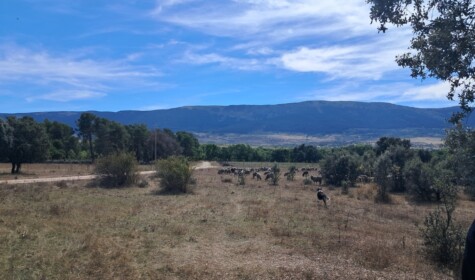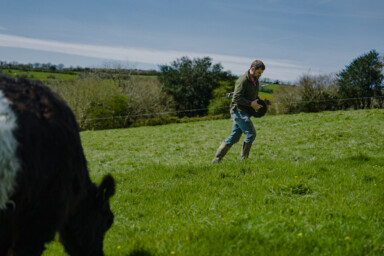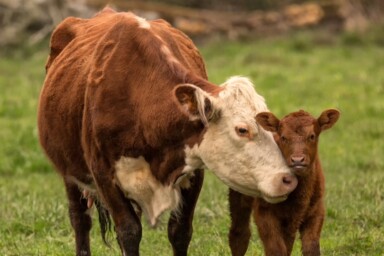Spanish merinos grazing
We talked about shearing. They shear in April and do it themselves to avoid having to pay the Eastern European shearing gangs to remove what should be a valuable crop but has become another cost in an already struggling industry. The ‘wool is worthless’ mantra is clearly not unique to Britain.
I spent much of this summer in the UK, at home in the West Country, working with a shearer and talking to customers about their fleece. Most intended to burn it, unable to see any alternative given the cost of transporting it to the British Wool collection points – on top of the cost of paying us for the shearing. Now I find myself in central Spain, repeating the same argument (with the help of Beth as an interpreter) that I had been making all summer to anyone who would listen. How insane is it to throw away this versatile natural fibre that the sheep of both Britain and Spain were developed for and choose instead to make our clothing and other fabrics from oil – a finite resource that, through our misuse, is poisoning our water, land and air?
The argument wasn’t lost on David and Antonio as the exchange of questions turned to meat and subsidies. To put it simply, Spanish shepherds cannot make a living from sheep as meat alone and depend heavily on subsidies. Antonio asked at what age I send sheep to the abattoir and when I told them it was usually around 18 months, they both seemed surprised. For my part, I was so surprised at the age they send theirs that I had to question the interpreter. “Did they really say 20 days?” I even held my hands out to the approximate size of a 20-day old lamb to check, but no, I had not misunderstood.
I explained how I believed that shepherding could only be sustainable, self-financing and profitable if wool was restored as an integral part of the product as a whole, and that this could only happen with the significant development of internal markets. I told them how my shearing partner and I were attempting to build a business around not just shearing the sheep, but marketing and processing the fleece, adding value for both us and our customers. We all agreed that this was a hard task but that it was really the only way forward for both our countries.
“How insane is it to throw away this versatile natural fibre that the sheep of both Britain and Spain were developed for and choose instead to make our clothing and other fabrics from oil – a finite resource that, through our misuse, is poisoning our water, land and air?”
The way forward and the way back – sheep were never really meant to be penned inside small paddocks of intensively farmed grass, unless it was for short periods to manure arable land. In Britain, most of the commons were lost to the Enclosures Act. With that came the loss of a centuries old tradition of moving sheep continuously across open downland and the seasonal movement of flocks between valley, moor and mountain. Here in Spain, the transhumance has continued into living memory and is still carried out by a few shepherds determined to maintain their deep-rooted cultural practices.
David pointed to a swathe of open grassland below the tree line on the nearby mountains. That, he explained, is the cañada – the drove road for the transhumance of the sheep to their over-wintering ground in Extremadura. It is a journey of 340 kilometres. Because the sheep have moved slowly across these long, wide droves, every spring and autumn for hundreds of years, a unique biodiverse habitat has been maintained by the brief bi-annual grazing and trampling. The sheep self-medicate on the abundant herbs along the way, and the shepherds have learnt through generations of transhumant families the value of those herbs to humans too. The grazing grounds in both Castilla y León and Extremadura get a long rest from sheep, again maintaining biodiversity, and significantly, reducing parasites and the need for chemical inputs.
“Here in Spain, the transhumance has continued into living memory and is still carried out by a few shepherds determined to maintain their deep-rooted cultural practices.”
I wanted to know if the wolves follow the flocks or wait for their return but there is too much to discuss, so that will be a question for next time. According to the International Wolf Center, “Incomplete statistics reveal that Spanish wolves kill some 10,000 head of livestock annually.”
All too soon, our meeting was over. David and Antonio had to get back to work and Beth and I had to go and find the family members that we abandoned in Pedraza. All of us agreed that the conversation needs to be ongoing, or as Antonio put it, “It would be very interesting to exchange ideas about the proper use of wool and responsible animal husbandry.”
A few days after my return to Britain, I had a message from Beth to say that Antonio had been in touch. He had spoken to a friend who still carries out the transhumance in their region. The friend would like to meet us and invites us to join him on at least part of his journey next year. I guess it’s time I learnt to speak Spanish!
If you’re interested in finding out more about sheep and transhumance in Spain, you can read Merino (Churras and Merinas), History, Culture, Landscape.
Featured images courtesy of Julie Baber.









